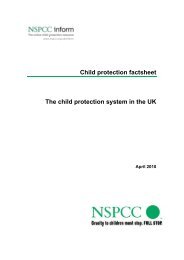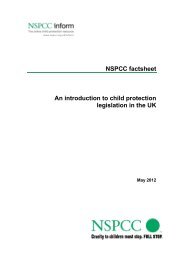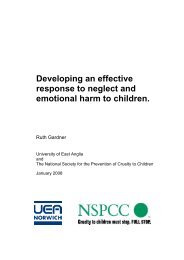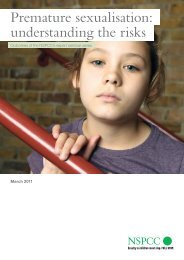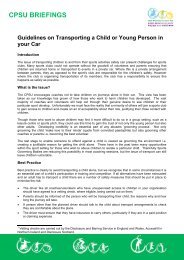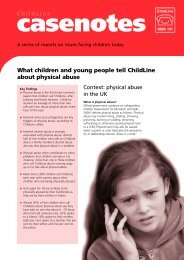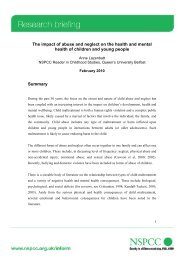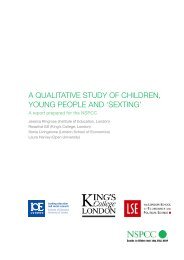Neglect and serious case reviews (PDF, 735KB) - nspcc
Neglect and serious case reviews (PDF, 735KB) - nspcc
Neglect and serious case reviews (PDF, 735KB) - nspcc
Create successful ePaper yourself
Turn your PDF publications into a flip-book with our unique Google optimized e-Paper software.
figure 2.1: age distribution of children with a (past or current) child protection plan<br />
for neglect compared with children with no plan<br />
50%<br />
45%<br />
40%<br />
35%<br />
30%<br />
25%<br />
20%<br />
15%<br />
10%<br />
5%<br />
0%<br />
2. <strong>Neglect</strong> in the lives of children who become the subject of a <strong>serious</strong> <strong>case</strong> review – a statistical overview<br />
30%<br />
45%<br />
24% 24%<br />
15%<br />
< 1 year 1–5 years 6–10 years 11–15 years 16 years +<br />
9%<br />
<strong>Neglect</strong> CP plan<br />
No CP plan for<br />
neglect<br />
Ethnic group: The ethnicity of the children who were the subject of a child protection<br />
plan for neglect broadly matches that of the comparative samples. Although there is<br />
arguably an over representation of minority ethnic children across all samples, this<br />
looks much less pronounced in the light of new information from the 2011 census which<br />
shows higher proportions of minority ethnic children in the population of Engl<strong>and</strong> than<br />
in earlier years.<br />
Gender: There was a higher proportion of girls (57%) with a CP plan for neglect than<br />
boys (43%). This was in contrast to the children without a plan for neglect, 44 per cent<br />
of whom were girls, <strong>and</strong> 56 per cent of whom were boys. Recent statistics on category<br />
of plan for 2011 in Engl<strong>and</strong> show that in contrast, nationally, there is a slightly higher<br />
proportion of boys (51%) with a CP plan for neglect, than there are girls (49%). A<br />
similar 52 per cent/48 per cent split is also apparent in the other categories of abuse,<br />
except for sexual abuse, where 57 per cent of those with this type of plan are girls (see<br />
also Appendix A).<br />
Family size: In these SCRs, a higher proportion of children with a CP plan for neglect<br />
lived in large families with four or more siblings than would be found in the general<br />
population. This was also true for children with a plan in any other category. In their<br />
large cohort study of over 14,000 children in the west of Engl<strong>and</strong>, Sidebotham <strong>and</strong><br />
colleagues (2006) cited a number of authors who had shown increased risks of child<br />
maltreatment in larger families. However Sidebotham’s multivariate analysis found<br />
that the marginally higher risk to the child in large families was accounted for by the<br />
confounding effects of parental background <strong>and</strong> socio-economic factors. In our analysis<br />
of <strong>serious</strong> <strong>case</strong> <strong>reviews</strong> from 2007–09 (Br<strong>and</strong>on et al 2010), we noted the additional<br />
stress, not least financial, that can come with a large family, <strong>and</strong> that professionals’ focus<br />
on individual children can be lost in such circumstances.<br />
21%<br />
12%<br />
11%<br />
10%<br />
25




